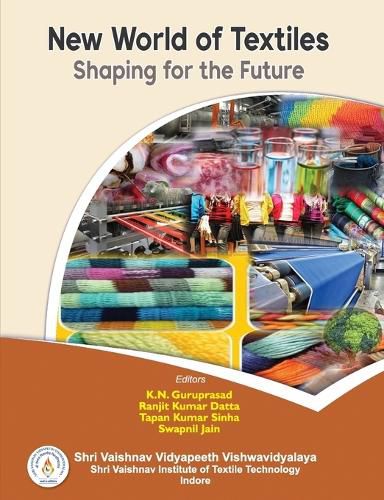Readings Newsletter
Become a Readings Member to make your shopping experience even easier.
Sign in or sign up for free!
You’re not far away from qualifying for FREE standard shipping within Australia
You’ve qualified for FREE standard shipping within Australia
The cart is loading…






This title is printed to order. This book may have been self-published. If so, we cannot guarantee the quality of the content. In the main most books will have gone through the editing process however some may not. We therefore suggest that you be aware of this before ordering this book. If in doubt check either the author or publisher’s details as we are unable to accept any returns unless they are faulty. Please contact us if you have any questions.
In the present COVID-19 crisis-hit world, while most countries are looking inward, India is using this an opportunity to reform its economy as well as rebalance international trade. The manufacturing of Personal Protective Equipment (PPE) kits during COVID-19 pandemic in six weeks is an example of innovative resilience of Indian textile industry with the support of various R&D institutes and the Ministry of Textiles (MoT) and today India is second largest producer of PPE kits in the world. Government of India has taken various proactive measures to reboot Indian textiles and apparel sectors like, Mega Investment seven textile parks, Production Link Initiative (PLI) in MMF and technical textiles to create world class infrastructure, with plug-and-play facilities to enable and create global champions in export. The Ministry of Textiles is in the process of formulating a New Textiles Policy 2020 with a vision to develop a competitive textile sectors. With a rapid growth in textile consumption in developing countries, a new range application area for textiles are constantly rising to meet the user requirements in terms of functionality, variety, precision, performance, reliability, and environ-mental friendliness of textile products. This transformation process will focus on the exploitation of research, innovation and knowledge-orientation across all business functions and sub-sector activities driven through multi-disciplinary approach that are shaping the future of textiles in novel application fields. The present book intends to draw attention towards the various areas in textiles at local, national, regional and global level to achieve the said targets. It also describes the recent trends and developments in the field of textiles. KEY FEATURES
Highlights crucial topics in the advancement of new textile fibers, textile engineering, textile chemical processing, handloom and handicraft, technical textiles, garment and fashion industry. Discuss sustainable and ecofriendly growth, developments in textile chemical processing, renewable energy, use of natural fiber in technical textiles in line with the current health issue in the post COVID-19 scenario. Throws light on agro-textiles, textile composites, natural dyes, industry 4.0, 3D woven fabrics, environmental pollution, vocal for local, and management tools for efficient controlling of the textile industry. Academicians, industries, research scholar and students will find this book of immense value and useful.
$9.00 standard shipping within Australia
FREE standard shipping within Australia for orders over $100.00
Express & International shipping calculated at checkout
This title is printed to order. This book may have been self-published. If so, we cannot guarantee the quality of the content. In the main most books will have gone through the editing process however some may not. We therefore suggest that you be aware of this before ordering this book. If in doubt check either the author or publisher’s details as we are unable to accept any returns unless they are faulty. Please contact us if you have any questions.
In the present COVID-19 crisis-hit world, while most countries are looking inward, India is using this an opportunity to reform its economy as well as rebalance international trade. The manufacturing of Personal Protective Equipment (PPE) kits during COVID-19 pandemic in six weeks is an example of innovative resilience of Indian textile industry with the support of various R&D institutes and the Ministry of Textiles (MoT) and today India is second largest producer of PPE kits in the world. Government of India has taken various proactive measures to reboot Indian textiles and apparel sectors like, Mega Investment seven textile parks, Production Link Initiative (PLI) in MMF and technical textiles to create world class infrastructure, with plug-and-play facilities to enable and create global champions in export. The Ministry of Textiles is in the process of formulating a New Textiles Policy 2020 with a vision to develop a competitive textile sectors. With a rapid growth in textile consumption in developing countries, a new range application area for textiles are constantly rising to meet the user requirements in terms of functionality, variety, precision, performance, reliability, and environ-mental friendliness of textile products. This transformation process will focus on the exploitation of research, innovation and knowledge-orientation across all business functions and sub-sector activities driven through multi-disciplinary approach that are shaping the future of textiles in novel application fields. The present book intends to draw attention towards the various areas in textiles at local, national, regional and global level to achieve the said targets. It also describes the recent trends and developments in the field of textiles. KEY FEATURES
Highlights crucial topics in the advancement of new textile fibers, textile engineering, textile chemical processing, handloom and handicraft, technical textiles, garment and fashion industry. Discuss sustainable and ecofriendly growth, developments in textile chemical processing, renewable energy, use of natural fiber in technical textiles in line with the current health issue in the post COVID-19 scenario. Throws light on agro-textiles, textile composites, natural dyes, industry 4.0, 3D woven fabrics, environmental pollution, vocal for local, and management tools for efficient controlling of the textile industry. Academicians, industries, research scholar and students will find this book of immense value and useful.